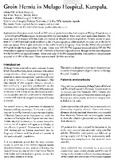| dc.contributor.author | Odula, Paul Ochieng' | |
| dc.contributor.author | Kakande, I. M. | |
| dc.date.accessioned | 2013-04-05T06:22:04Z | |
| dc.date.available | 2013-04-05T06:22:04Z | |
| dc.date.issued | 2000 | |
| dc.identifier.citation | http://www.bioline.org.br/request?js04012 | en |
| dc.identifier.uri | http://www.bioline.org.br/request?js04012 | |
| dc.identifier.uri | http://erepository.uonbi.ac.ke:8080/xmlui/handle/123456789/15365 | |
| dc.description.abstract | A prospective descriptive study based on 208 cases of groin hernia that had surgery at Mulago Hospital over a
12-months period beginning on 1st January 2000 was undertaken. There were more males than females. The
mean age was 35.4 years with the mode and median of 40 and 33 years respectively. Patients under 15 years
were 37 (17.8%) and had a peak incidence in the 1-3 years age group while in adults the peak was in the 24-34
years age group. Only 2 girls were seen in the under 15 years old group. Most females (86%) who presented
with groin hernias were aged above 34 years. There were 195 (93.7%) inguinal hernias of which 159 (81.5%)
were indirect inguinal hernias and 34 (17.4%) were of the direct inguinal variety. Busoga hernias were diagnosed
in only 4 (2.05%) of inguinal hernias. There were only 13 (6.2%) femoral hernias. Post-operative complications
occurred in 41.8% of the cases. There was one death. (0.48% mortality). | en |
| dc.language.iso | en | en |
| dc.title | Groin Hernia in Mulago hospital, Kampala. | en |
| dc.type | Article | en |
| local.publisher | Department of Human Anatomy, Universoty of Nairobi | en |

